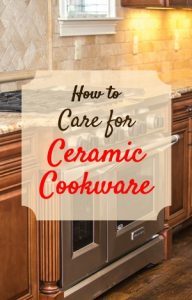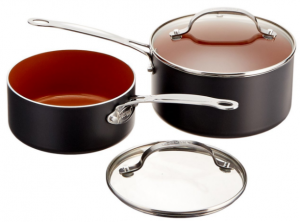 Are you contemplating buying a set of ceramic cookware, but you’ve heard that they’re a hassle to take care of? I want to ease your mind and let you know that while there are certain things you’ll do a little differently with these, the differences really are simple to implement. You’ll just have to remember to do them, but in no time it will become second nature to you. And you may even be doing some of these things already in caring for your current set. Below, we’ll cover the general dos and don’ts that are recommended by most manufacturers.
Are you contemplating buying a set of ceramic cookware, but you’ve heard that they’re a hassle to take care of? I want to ease your mind and let you know that while there are certain things you’ll do a little differently with these, the differences really are simple to implement. You’ll just have to remember to do them, but in no time it will become second nature to you. And you may even be doing some of these things already in caring for your current set. Below, we’ll cover the general dos and don’ts that are recommended by most manufacturers.
Use only safe utensils in ceramic coated pans
Do not use metal utensils. Always use silicone, wooden (preferable bamboo), plastic or nylon utensils to stir with or serve from. I prefer to use rubberized silicone spoons, spatulas or tongs since they are softest and seem to be perform the best on the surface. Metal utensils have hard, sharp edges that will chip or scratch the surface. If the ceramic finish gets scratched up the coating will lose its nonstick performance, so by using safe utensils you’ll extend it’s life span.
Never use cooking oil sprays
Cooking-oil sprays from aerosol cans are so popular and easy to use, but this is one thing to NEVER use on ceramic skillets or pots. Not even the coconut oil or olive oil ones. These sprays have other ingredients and chemicals that will cause a sticky buildup on the surface. Besides, you really don’t want the added chemicals into your food. Many of these sprays also contain soy lecithin, which adds to the buildup. This gooky buildup doesn’t wash off easily, nor does it burn off, and will eventually start to smoke. And if it gets to the point where you have to use a scrubbing pad to try to remove the film, the hard scrubbing in itself can cause peeling, scratching and damage to the once beautiful finish! If you really want to use some sort of oil spray, I’d recommend using a spray mister instead.
Some brands like WearEver recommend seasoning the pans before first use, and others say it’s not necessary. Some recommend to add a little butter or oil (but not extra virgin olive oil —it cannot withstand high heat levels and will leave a carbonized layer on the surface, plus the extra virgin olive oil heated at higher temps can can cause health issues), and others recommend no oil. Personally, I have found that over time the non-stick surface can become a little less non-stick so at that point I just add a tiny amount of oil or butter anyway. It’s always best to follow the specific manufacturer instructions though, as each brand’s surface is formulated with different technologies.
Cook on medium to low heat
Using higher than medium temperatures will cause discolor and damage as well as cause the nonstick finish to become very not nonstick, even after just a few time of doing this. It has great heat conductivity and the aluminum or hard anodized aluminum base also distributes heat effectively, so higher temps are not needed to cook your food quickly and evenly. And if you’re wondering if you can boil water or sear foods at a medium temperature, the answer is yes, all because of the special heat distribution properties. Also, if you are using oil or butter, it’s good to pre-heat your pan on a low setting and allow the oil to heat before adding your food to the pan.
Do not let your pans go from cold to hot or vice versa too quickly
Drastic changes in temperature can thermal damage to the non-stick coating, so the heating and non-stick cooking performance will be reduced. Never immerse a hot pan into water. Right after cooking, place your skillet or pot on a cool burner and let it cool to room temperature before you wash. By doing this, you’ll definitely improve the lifespan of your cookware.
Do not put your ceramic cookware in the dishwasher
Always wash by hand—even if the manufacturer says it’s fine to use in the dishwasher. There are a few reasons for this: One, most dish washing detergents have harsh chemicals that will ruin the surface in no time—it just cannot withstand that type of treatment. Second, the pressure of the hot water being sprayed onto the pans is extremely hard on the pan’s surface as well. Lastly, the pan can become scratched or chipped while clinking against other pans or dishware.
While this can seem like a drawback, it’s really so simple to just hand wash them anyway with a gentle dish soap and a soft sponge or cloth. They’re really quick and easy to clean, and by drying them right after cleaning, that will also help to preserve the surface.
Store the cookware safely
Do not stack the pans on top of or inside of each other during storage. It’s good to either use the round circular packing cardboard that came with your set in between the pans, or else a sheet of paper towel, or even old washcloths will do. There are also special decorative cloths or pan protectors sold online just for this purpose. Another option is to hang your pans. Many folks like to add a decorative accent to their kitchens by hanging their cookware. Most cookware nowadays has holes on the handles so you can hang them.
Hopefully, this list has helped you understand a little more what goes into the care and use of ceramic cookware. As I mentioned above, the list can seem daunting, but once you get used to handling your cookware this way, you’ll get used to it and it won’t seem like a chore at all. And the benefits will be healthy cooking, and fun cookware that’s actually fun to use!
